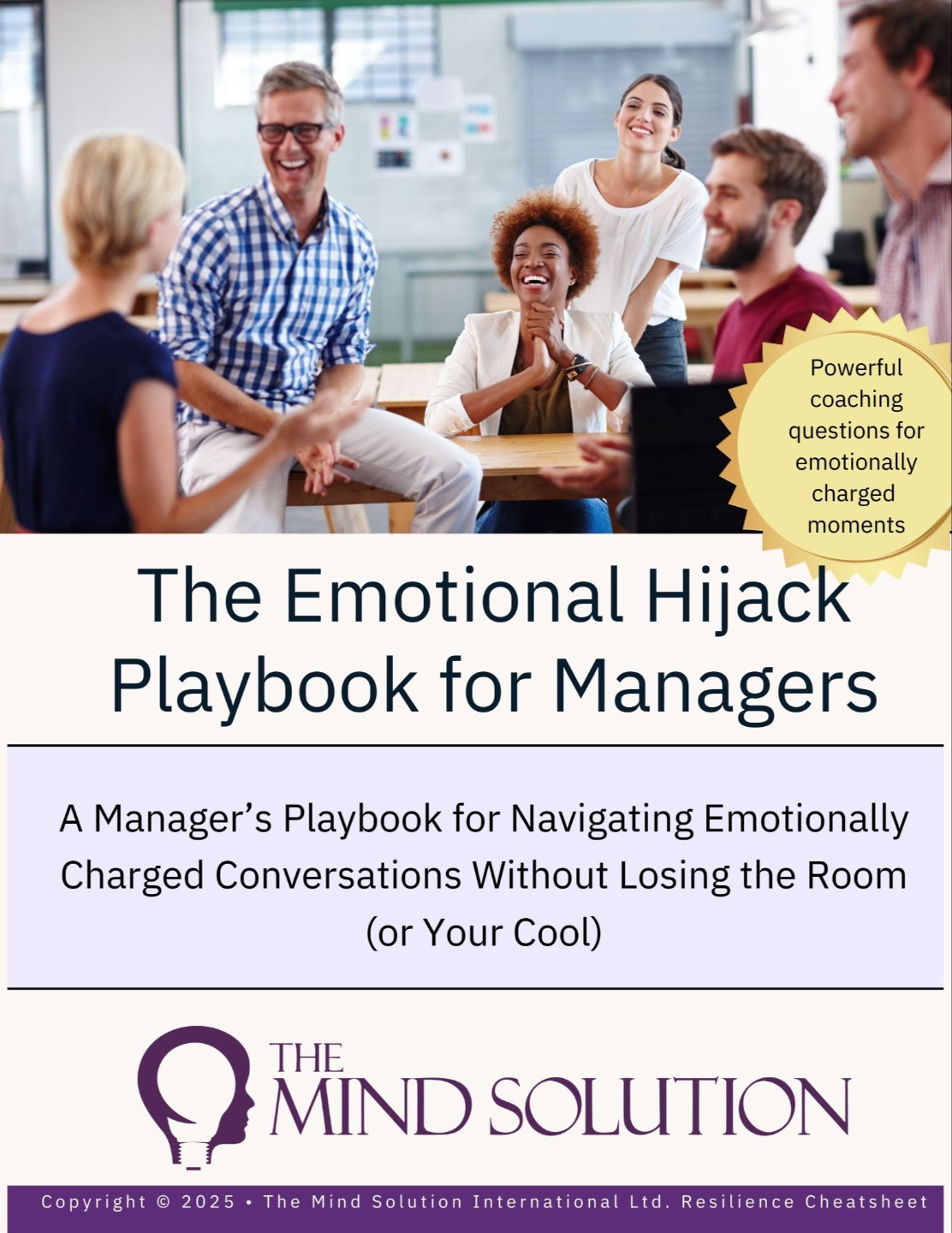How to Maximise the Impact of Your Mental Health Training for Managers
Aug 06, 2025
Designing Mental Health Training for Managers That Delivers Real Impact
I love the fact that more and more organisations are seeing the value of investing in mental health training for managers. Having worked in the corporate world as an HR professional for over a decade, I know firsthand the impact that a manager has on a member of their team.
That relationship is pivotal, not just in terms of managing performance, but also about clarity, strategy, motivation, support, and mental health.
And yet, despite all the talk about wellbeing, mental health, and employee support, many organisations are still missing a key truth: the manager–employee relationship is the frontline of mental health support in your business.
Is Mental Health Still Seen as Just an HR Problem?
Let’s be honest, employee wellbeing has long been seen as HR’s responsibility. Even now, I see this belief playing out in organisations. If someone is struggling, managers often default to HR. If there’s an absence due to stress, HR are the one who gets called.
But here’s the truth: the bigger the organisation, the less visibility HR has into what’s going on. If you’ve got 1,000 employees and an HR team of 10, they simply don’t have front-row seats to the lived experience of everyone in the business. Managers do.
Even in hybrid or remote setups, managers are still much closer to people’s day-to-day realities. Which means they’re in a prime position to spot the early signs when someone is struggling, to have meaningful conversations, and to intervene early, if they’ve been trained and supported to do so.
What’s the Real Goal of Your Mental Health Training for Managers?
One of the first questions I ask organisations is: what are you trying to achieve with this mental health training?
Yes, we all know that mental health training is good practice. But what's the outcome you want? What do you want managers to walk away with? What would success look like—not just immediately after the training, but three months down the line?
Are you looking to reduce absenteeism? Improve psychological safety? Increase confidence in having mental health conversations? What data will you use to measure impact?
This clarity matters. It helps shape the training, the format, and the long-term plan. Without it, training can quickly become another tick-box exercise.
Should You Try to Cover Everything in One Training Session?
Mental health is a huge topic. And one of the biggest mistakes I see is organisations trying to cover everything at once.
I’m a big believer in breaking things down and delivering training over time. You might start with the most common types of mental health challenges, such as stress, anxiety, depression, and trauma. But if your organisation has unique challenges, that should shape the content.
When I delivered training for the British Council, we included content on bipolar disorder because they had a high number of employees impacted by it. When I worked with Tesla and their manufacturing units, we covered addiction, because that’s what the data told us was needed.
Your training should be relevant, not generic. And that starts with understanding your people.
How Can Data Shape Your Mental Health Training Strategy?
Data isn't just for your board reports. It should guide your training.
Start by asking managers what they need. What are they seeing? What are they worried about? Where do they feel out of their depth?
You’d be surprised how few organisations have asked their managers these questions before commissioning training. But when you do, two things happen: the training becomes more relevant, and you create instant buy-in.
Because it’s not just training that’s being delivered to them—it’s something they helped shape.
Why Should Senior Leaders Attend Mental Health Training Too?
This one’s non-negotiable. If you want your mental health training to make an impact, your senior leadership team needs to be visibly on board.
I’ve run sessions where the CEO and executive team were present, actively engaged, and contributed throughout. And let me tell you, it sends a powerful message.
It says: This is important. We’re in this with you. Mental Health matters to us.
I’ve also run training where the senior team were conspicuously absent. And guess what? That was noticed too. I’ve had people mutter, “Well, where’s the leadership team? Is this not relevant for them?”
Whether it’s intentional or not, their absence communicates that this work isn’t a priority. That they’re above it. And that erodes trust before you’ve even started.
Can 90-Minute Mental Health Training Sessions Be Effective?
Some organisations want to deliver training in just 90 minutes, and that’s fine. But you need to be realistic about what can be achieved in that time.
If you’ve got 30 people in a session, and they’ve got questions (which they will), that eats into the time available for content. So manage expectations. A 90-minute session isn’t going to radically shift a culture—but it can be a powerful starting point.
What I recommend is spacing training out. Deliver it in 90-minute or two-hour blocks over several weeks. This is especially effective for online delivery, and it works brilliantly for global organisations.
What’s the Ideal Format for Delivering Mental Health Training?
Based on hundreds of sessions I’ve delivered, both in person and online, the format that works best is breaking training into modules that build over time.
Here’s what we’ve seen work:
Module 1 – What is mental health? How to spot the signs when someone is struggling. We address myths and concerns right from the start.
Module 2 – Listening skills and solution-focused coaching. This is where we teach managers how to have helpful conversations without getting overwhelmed or diving into problem-solving mode. We introduce powerful questions they can use straight away, and explore the importance of psychological safety.
Module 3 – Case studies and practice. This helps bring everything together. We explore real scenarios and invite managers to reflect on how they’d respond.
Module 4 – Emotional intelligence, self-awareness, and how to manage yourself when supporting others. Because managers are humans too.
This modular approach gives people space to reflect, apply what they’ve learned, and come back with insights or challenges the following week. It’s also how the brain learns best, through repetition and spaced learning.
How Do You Reinforce Mental Health Training After Delivery?
One-off training sessions are rarely enough. To embed learning, you need rhythm and repetition.
That’s why we back our training with follow-up emails and access to our employee wellbeing platform. Managers receive weekly reminders, prompts, and bite-sized resources to keep the learning alive.
The brain needs to hear something more than once in order to retain it. And your culture needs consistency in order to shift. Training shouldn't be something you did two years ago. It should become part of the way your business operates.
Why Run a Pilot Mental Health Training Session First?
If you’re thinking about investing in mental health training for managers, consider running a pilot session first.
We did this recently with a large organisation—starting with a session for their senior leadership team. It gave them a clear sense of what the training included, how it was delivered, and whether it met their needs.
The feedback was so strong that they immediately booked 10 further sessions for their managers.
And while we didn’t need to change anything based on the pilot feedback, it gave everyone a chance to align expectations and tweak the rollout plan. It also built early momentum.
What’s the Next Step to Bring Mental Health Training Into Your Organisation?
If you're reading this and thinking, Yes—we need this, then here’s your next step.
Whether you want to run a pilot, book a discovery call, or explore your specific needs, we’re here to help you bring high-impact mental health training to your managers.
This is more than a box-ticking exercise. It’s about equipping the people who are closest to your employees with the confidence, tools, and self-awareness they need to create a culture where wellbeing is real—and sustainable.
The Emotional Hijack Playbook For Managers
A Manager’s Free Resource for Navigating Emotionally Charged Conversations Without Losing the Room (or Your Cool).
Perfect to use in your next one-to-one.







